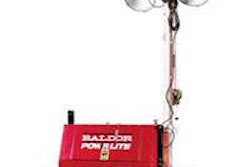You need the right stuff to win a paving award.
Super Smooooth Delivery
Placement of a 1/2-inch asphalt leveling course and careful screed control helped the contractor win a Quality in Construction Award from the National Asphalt Pavement Association (NAPA). Scotty’s Contracting & Stone, LLC, won the award for 6.2 miles of Interstate 65 in Barren and Hart Counties, Ky.
The use of a mobile mat referene on the Blaw-Knox paver helped to produce a smooth pavement on this section of Interstate 65 in Kentucky.Scotty’s bid included money to pave the full 10-foot outside shoulder on the Interstate, but the state decided not to pave the entire area. By only paving 4 feet of the outside shoulder, Scotty’s realized some savings that were applied to paving the 1/2-inch leveling course. “We took that savings and put it toward the leveling course over the full 32-foot width of pavement, which is really what helped us obtain the ride we did,” says Jared Nix, quality control manager for Scotty’s Contracting.
The contractor paved the full 32 feet wide in two 16-foot pulls. Each of those pulls covered a 12-foot driving lane and 4 feet of shoulder. Scotty’s had used a Roadtec milling machine to remove 1.5 inches of asphalt, so after the leveling course, the Blaw-Knox paver put back 1.5 inches of hot-mix asphalt (HMA).
All the paving was done at night. The contractor could only close down to one lane between 6 p.m. and 6 a.m. “We paved during the day on the ramps,” said Nix.
Thanks to the use of a Roadtec Shuttle Buggy and a mobile mat reference on the paver, Scotty’s achieved exceptional rideability and earned an incentive for it. The mobile mat reference has a bridge that goes over the screed and runs a reference on the uncompacted mat just placed.
Quality from a high production operation
The use of a Roadtec Shuttle Buggy and a Topcon non-contact ski to control the paver helped Orlando Paving Co., Orlando, Fla., achieve award-winning smoothness on an asphalt mill-and-fill project in Florida. The project, on SR 528, won a 2009 Quality in Construction Award from the National Asphalt Pavement Association.
The project covered 66 lane miles and entailed milling up 3.5 inches of asphalt, then placing two structural lifts back – first a 2-inch lift, then a 1.5-inch lift. The contractor did not use the Shuttle Buggy for the two structural lifts, but did so for the 3/4-inch (0.75-inch) open-graded friction course on the surface.
“With the Shuttle Buggy you keep a constant movement, a steady pace and you virtually eliminate segregation,” says Paul Miller, construction manager for Orlando Paving. The results on the surface course were superb: a 4.17 ride number on a laser profiler, with 5.0 being the best possible score. “The paver moved along at about 30 to 35 feet per minute,” says Miller. “Anything faster would be moving too fast.
“We didn’t use the Shuttle Buggy for the structural courses due to availability of the machine,” Miller says.
The contractor produced and laid 160,000 tons of hot-mix asphalt in just 310 days. All paving was done at night on the heavily traveled roadway, which carried between 45,000 and 90,000 vehicles per day. The contractor worked the project between 8 p.m. and 6 a.m. on the mainline and 10 p.m. to 5 a.m. for the ramps.
Essentially, this only left six hours to pave because of the time required to mobilize and demobilize traffic control devices and to stripe the pavement at the end of the shift.
Even though it was a high-production operation, safety came first, Miller said. The project was completed, under heavy traffic, with no accidents involving the construction operations. “On a project like this one, we have a number of safety procedures to plan and set up, and we make sure that we have the discipline to follow them,” Miller points out. “We had safety meetings every night before work began and discussed in detail the objectives for success, and made sure that everybody knew the stopping and starting stations every night. At Orlando Paving, safety is our culture and we are dedicated to protecting our personnel as well as the traveling public. Working safely is a matter of good common sense, but you need to have the commitment to use all the right procedures and protocols.”
Three pavers are the charm
Operating three concrete pavers helped this contractor gain time and meet the schedule for a three-mile road construction project in St. Joseph, Mo. For Loch Sand and Construction Co., Maryville, Mo., the Route AC project on Riverside Road won a 2008 Silver Award in the State Roads category for Excellence in Concrete Pavement from the American Concrete Pavement Association.
Approximately half of the 3-mile section was four-lane divided highway with two driving lanes plus shoulders on each side. The remainder of the project was 56 feet wide including shoulders, said Rob Loch, treasurer and equipment manager for Loch Sand and Construction.
“We had a hard winter and we ran into subgrade issues, which put us behind schedule,” Loch says. “So we were looking for any way to pick up some time. Bringing in the three pavers helped expedite the paving work and complete the project in early November, before the season ended.”
Running the three pavers precluded the need to change widths on one concrete paver, which saved at least a week, Loch says. The contractor used one Gomaco 2800 working 20 feet wide, another Gomaco 2800 working 24 feet wide, and a Gomaco Commander III to slipform an 8-foot shoulder. The 20-foot-wide paver slipformed the variable median section in two passes. Meanwhile, the 24-foot paver slipped the divided highway section.
The project included some 33,000 square yards of 9-inch-thick doweled concrete pavement and 14,500 square yards of 6-inch-thick concrete shoulders. How was the smoothness? “We averaged 27.3 inches of deviation per mile from a zero blanking band,” Loch says. Anything less than 30 inches qualified for 100 percent pay.
The keys to smoothness were placement of a sound subgrade and base, an excellent track pad, a carefully set stringline and experienced paving crews, Loch says.
A wet and plastic subgrade proved to be one of the project’s major challenges. “We removed a pavement on the north end of the job, and placed shot rock to stabilize the area,” Loch says. “We also ran into springs of water, so we installed a system of French drains to carry away excess groundwater.”
The value of electronic grade controls
Using a Roadtec Shuttle Buggy and electronic grade controls proved the keys to exceptional smoothness on a mill-and-overlay project in Hinesville, Georgia. APAC-Southeast of Savannah, Ga., won a 2009 Quality in Construction Award from the National Asphalt Pavement Association for pavement construction on SR 119 and SR 196.
The Georgia DOT specifies that a milled asphalt surface meet a smoothness requirement of 1,325 millimeters/kilometer — and the finished pavement must meet a spec of 1,025 millimeters/kilometer. “So we used our electronic grade controls on the milling machines,” says Robert Royal, area manager for APAC-Southeast in Savannah.
The project was 4.734 miles long, and APAC used two milling machines — a Roadtec RX50 with a Topcon System 5 and a Wirtgen W2000 with a Moba electronic grade control system. Milling depth was 1.5 inches, and APAC replaced that with 1.5 inches of new hot-mix asphalt.
For the paving, APAC used a Roadtec SP100 Stealth paver equipped with a Topcon System 5 electronic grade control. “It’s a four-head sensor system with non-contact skis suspended from each side of the paver,” Royal says. The APAC paving crew improved the ride of the old pavement by 46 percent.
“Smoothness of milling is all about continuity and truck management,” Royal notes. “We operated the milling machines at a pretty slow travel speed, to permit more revolutions per minute of the cutter. Plus we wanted to flow the trucks smoothly to and from the mill’s conveyor belt. With paving, you want to minimize stops of the paver, and that’s what the Shuttle Buggy will do. By serving as a transfer vehicle, it helps maintain continuity of the entire paving operation.”
All milling and paving was done at night, under traffic. “We have a dedicated traffic control crew that pre-places our maintenance-of-traffic (MOT) devices,” Royal says. “They ride the lane closures and move the MOT devices as needed to make sure we follow the state specs. We ran between 18 and 22 trucks on mainline pulls.
The trucks hauled asphalt 36 miles from the plant in Savannah to the site in Hinesville, Royal says, and there was “excellent project management to coordinate between the roadway and the plant.”
James D. (Darrell) Cannon was the project manager; Joe Hires was the quality control manager. Jeff Andrews served as operations manager and Elmer Baggett, equipment manager, “was a tremendous help in making sure that all of the paving equipment and corresponding electronics were set up properly and in good working order,” Royal says.
Dust breaks the concrete-asphalt bond
Excellent smoothness results on a concrete overlay produced an award-winning project for Duit Construction Co., Edmond, Oklahoma. Duit won a 2008 Gold Award for Excellence in Concrete Pavement from the American
Concrete Pavement Association in the Overlays category.
On a 10-mile stretch of Interstate 35 near Stillwater, Okla., Duit averaged 1 inch per mile of deviation from a 0.20-inch blanking band. The specification called for a maximum of 6 inches per mile. The contractor earned 100 percent incentive payments for 3 inches of deviation or less per section of pavement.
The original pavement consisted of 10 inches of asphalt. A Duit subcontractor milled 4.5 to 5 inches of the asphalt, taking care to control the profile of the remaining asphalt. A properly graded asphalt base helped to achieve the concrete smoothness results. It required four passes to mill the 26-foot wide pavement.
Duit used two concrete pavers to place the 8.5-inch thick concrete overlay. The lead paver, a CMI-made SF 450, a four-track paver, worked 26 feet wide to spread the concrete, which trucks had placed on the asphalt. Mounted behind the lead paver was a dowel bar inserter, which placed dowels at 15-foot intervals. The second paver, a CMI-made SF 6004, performed the finish paving, said Gary Gaul, executive superintendent for Duit. (CMI has been incorporated into Terex Corp.)
It was an unbonded overlay. The dust from the milling operation served as a bond breaker between the asphalt and the concrete.











